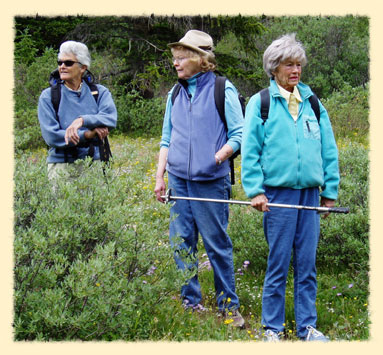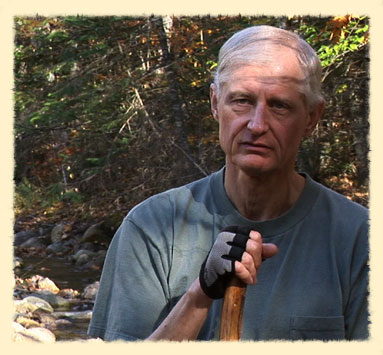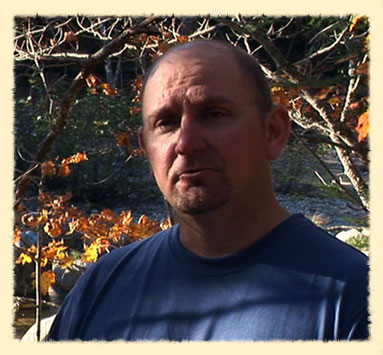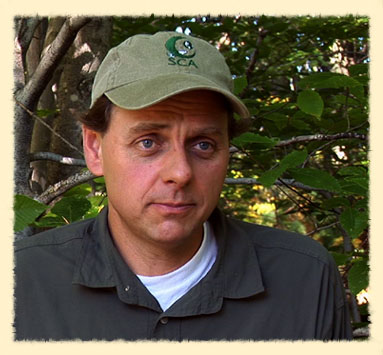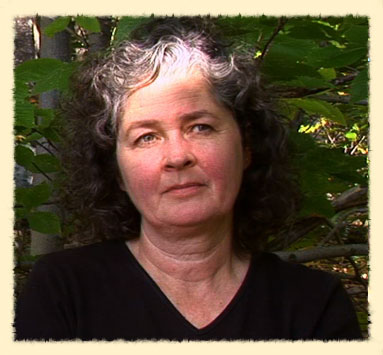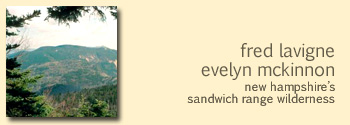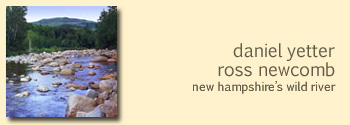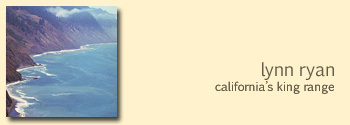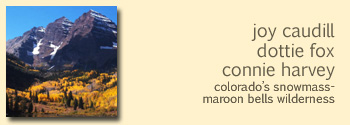
"Never doubt that a small group of thoughtful committed citizens can change the world. Indeed, it is the only thing that ever has."
Read Their Stories Below Fred Lavigne is a third generation, self-employed logger in Sandwich, New Hampshire: "When I'm not cutting them, I'm hugging them," jokes Fred. "You can be both. Being a logger doesn't mean a person is opposed to wilderness and to protecting places." Evelyn McKinnon is an elementary school teacher in New Hampshire with 20 years experience. "My bridge building and mediation skills have come in handy in our work with the Forest Service and other stakeholders." Fred and Evelyn, a husband and wife wilderness team from Sandwich, NH, along with a small band of fellow wilderness advocates formed Friends of the Sandwich Range (http://www.whywilderness.org/) in 1998 to protect wild areas in New Hampshire's popular White Mountain National Forest. The Friends of the Sandwich Range embarked on an effort to add eight special areas to the existing Sandwich Range Wilderness, which was designated in 1984. The proposed Black Mountain Pond Wilderness Extension contains some of the richest bird habitat in the area as well as wildlife like peregrine falcons, moose, bear, and other creatures. The Friends of the Sandwich Range also proposed that the abandoned community of Sandwich Notch be designated as a Historic Area to provide long-term protection for the many significant sites including barn foundations, mill sites, and wells, in addition to the remains of one of the longest logging railroads in White Mountain history. The birth of Friends of the Sandwich Range was fortuitous as it occurred just at the start of the revision of the White Mountain National Forest's forest management plan. They reached out to U.S. Forest Service personnel, snowmobile users, and the timber industry, among others. Through the eight-year effort, The Wilderness Society and Appalachian Mountain Club provided crucial guidance and support to the Friends. Fred and Evelyn made multiple trips to the Washington to meet with congressional staffers and other people with influence to educate them about the importance of wilderness to New Hampshire. More important than visits to Washington was the work done in their community and out in the forest. The Friends of the Sandwich Range developed a slideshow of the areas they were working to protect, and used it to educate their community about wilderness. They led hikes and spent a lot of time on the land. "It's important that you get to know the land better than the agency does," says Fred. "You have to know what you're trying to save, and it gets you fired up when you know there could be a road or a timber sale in an area. It puts the fight in you." Evelyn provides additional counsel. "Be patient. We would have liked it to happen more quickly, but it really does take time. Remember to get out there and enjoy it while you're protecting it.” In late March 2006, Senators John Sununu (R-NH) and Judd Gregg (R-NH) introduced the New Hampshire Wilderness Act of 2006, legislation to permanently protect 34,500 areas in the Sandwich Range and Wild River region of the White Mountain National Forest as Congressionally designated wilderness. The Act was signed into law in December 2006. The Friends of Wild River are volunteers who came together in 1998 to work to have the Wild River designated as wilderness. Daniel Yetter, a retired electrical engineer, and Ross Newcomb, a retail manager, founded the group. They wrote books, composed music, produced a slide show and talked to thousands of people about the unique values of the Wild River. New Hampshire's White Mountains have been a destination for hikers for well over a century. Home to the highest peaks in the northeast, the area was heavily logged in the 19th century. Congress responded to public concerns about the vast clearcut logging areas and wildfires with passage of the Appalachian-White Mountains Forest Reservation Bill in 1911. Mountainsides and valleys once scarred by clearcut logging, roads, and railroads, have now re-grown and re-vegetated themselves so that the White Mountains now contain the largest undeveloped expanses of any national forest in the East. The White Mountains possess two large, spectacular wild watersheds: the 45,000-acre Pemigewasset Wilderness, designated as wilderness in 1984, and the Wild River Valley. The Wild River Valley is a northeast-facing valley surrounded on three sides by mountains that encompass a 27,000-acre lowland interior valley where one finds a wealth of rare forest habitats for a wide range of wildlife and plants. Including the outer slopes, the Wild River area totals more than 70,000 acres. Wild River is a vast, stunningly alive, intact watershed. Signs of wildlife — moose, spruce grouse, songbirds, coyotes, fisher, bears, beaver, deer, and the threatened pine martin — fill the valley. Continuing to shed many of the effects of early abuses, the valley is maturing toward a majestic wooded area, free of human development, across 42 square miles. Today, remnants of the original forest can be seen in a few massive hemlocks along the Wild River, as well as in gnarly old maples and yellow birch in the southern portion of the valley. The Appalachian Trail traverses the Carter-Moriah Range on the west side of the valley. Carter Dome, with an elevation of 4832 feet, towers over the area affording spectacular views. Beginning in 1999, the Friends of Wild River participated in the U.S. Forest Service’s Forest Plan Revision Process to share their vision for Wild River. They attended meetings, and lead forest service employees and elected officials on hikes in the area. In 2006, after eight years of effort dedicated to preserving the Wild River Basin, the U.S. Forest Service recommended that Congress designate a 24,000-acre wilderness within the White Mountain National Forest. Subsequently, the Friends of Wild River joined their wilderness proposal to the proposal for the Sandwich Range Wilderness. In late March 2006, Senators John Sununu (R-NH) and Judd Gregg (R-NH) introduced the New Hampshire Wilderness Act of 2006, legislation to permanently protect 34,500 areas in the Sandwich Range and Wild River region of the White Mountain National Forest as Congressionally designated wilderness. The Act was signed into law in December 2006. For more information see: Lynn Ryan was born in Wyoming and raised in Wisconsin, where she lived until she graduated from nursing school at age 21. At that point, she drove West in a Volkswagen bus to find new adventures and landed in Santa Barbara, California where she lived until the late seventies. In Santa Barbara, there was a beach she liked to visit. However, the neighbors complained about dust on the road to the beach, and they were concerned about acts of violence that had been occurring in the area. Lynn and local residents formed an ad hoc group. They worked to close the road to the beach and put the parking lot a half mile away. Closing that road decreased dust and noise, the fighting and violence went away, and wildlife came back. The place was healed through successful grassroots organizing. In 1981, Lynn moved to the town of Arcata in Northern California. Soon after moving north, Lynn discovered the King Range and the Lost Coast. The Bureau of Land Management (BLM), the agency that manages the King Range, was working to open the area to roads and vehicles, in large part so that logging companies could access the area and its ancient Douglas fir and redwood trees. Lynn was truly the keeper of the King Range. She joined with the California Wilderness Coalition (www.californiawild.org) which put her in touch with other local people in its network. Throughout the eighties and nineties Lynn and other local citizens worked to defend the forests and rivers of the King Range, South Fork Eel, and Yolla Bolly areas. Their tactics included education, hikes, letter writing campaigns, and non-violent direct action. "We kept those areas wild and roadless until they could be protected as wilderness." Finally, Lynn helped marshal local citizens to advocate the inclusion of the entire area in the wilderness legislation that was being developed for the region. Lynn’s 20-year effort was rewarded in the fall of 2006 with the passage of the Northern California Coastal Wild Heritage Wilderness Act. The legislation designated approximately 275,000 acres of wilderness, including the South Fork Eel, King Range, and additions to the Yolla Bolly Wilderness. Because of Lynn's work and the work of others, California's King Range, with its famous "Lost Coast" — the longest stretch of undeveloped coastline in the U.S. outside of Alaska — will remain wild and free forever. Ryan Henson, Policy Director for the California Wilderness Coalition, spoke on behalf of many individuals involved with the North Coast wilderness effort when he said: "Lynn was absolutely instrumental in the effort to protect the King Range as wilderness. She has been working to preserve the area's wild character since the 1970s, and over the last few years we started calling her Ms. King Range. I wish all wild places had friends like Lynn." Environmental heroes get started in many ways. Joy Caudill, Dottie Fox and Connie Harvey, came together because they shared a neighborhood bridge and a love for the wild natural environment that surrounds their homes in Colorado. The Wilderness Act of 1964 protected 80,000 acres of the White River National Forest surrounding Aspen. But acres of pristine wild lands were not included and mining and development threatened many tracts of land. Early on, the three women understood the power of the Wilderness Act: it created a mechanism that allowed individuals to petition the government to create new wilderness areas. Connie Harvey, Joy Caudill and Dottie Fox –– nick-named the “Maroon Belles” –– founded an environmental organization, the Aspen Wilderness Workshop, to protect the wild places they loved most. They were pioneers in organizing grassroots support for wilderness. They recruited their friends to explore potential wilderness areas surrounding Aspen, annotate maps, amass data and circulate petitions with local, state and national governments. This effort directly influenced several wilderness bills, including the Endangered American Wilderness Act of 1978 and the Colorado Wilderness Act of 1980. As a result of the campaign conducted by these three women and the Wilderness Workshop, more than 400,000 acres were added to the National Wilderness Preservation System including:
Clean air and pure water begin in Colorado’s wilderness. Crystalline streams carry precious rain and snow to rivers that water vast areas of the American West. The expansive ecosystem they helped protect is the home to a rich community of insects, plants and animals. For many species, it is their last refuge in a crowded world. Today, the Wilderness Workshop (www.wildernessworkshop.org) continues working in the spirit of Joy, Connie and Dottie on a new generation of wilderness for Colorado. “The high country has always been important to me because it just speaks to me.” “I have always had such clarity that some places need to be protected.
” “If you sit there in the wilderness where there are no man-made structures, no roads, no machines, nothing going on but the song of a bird . . . . you ’re ready to make enemies, anything to save the land you love most.” - Dottie Fox. |
